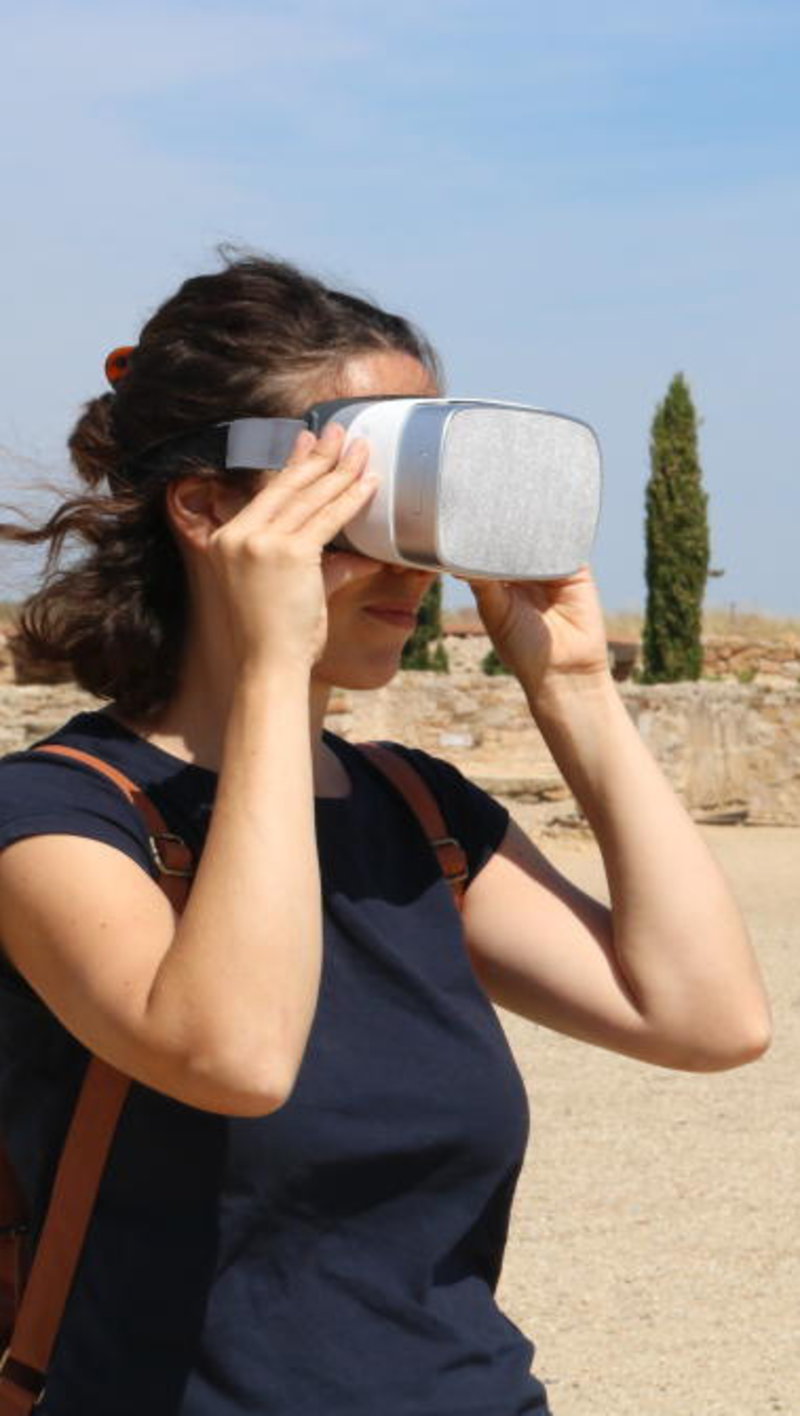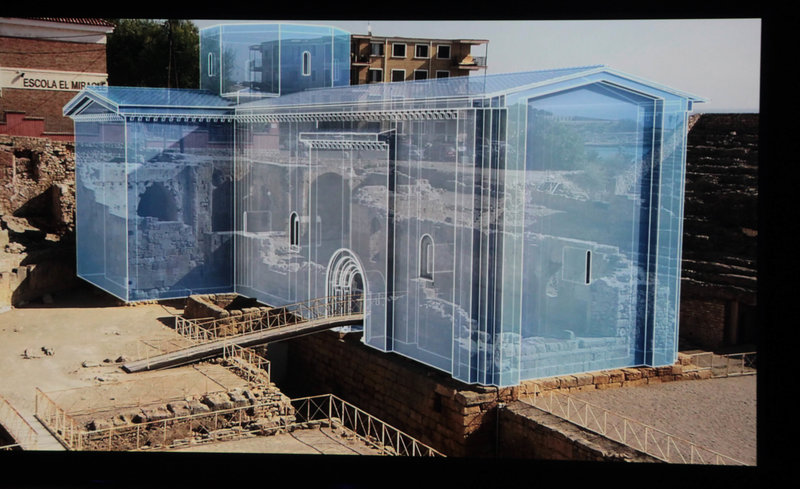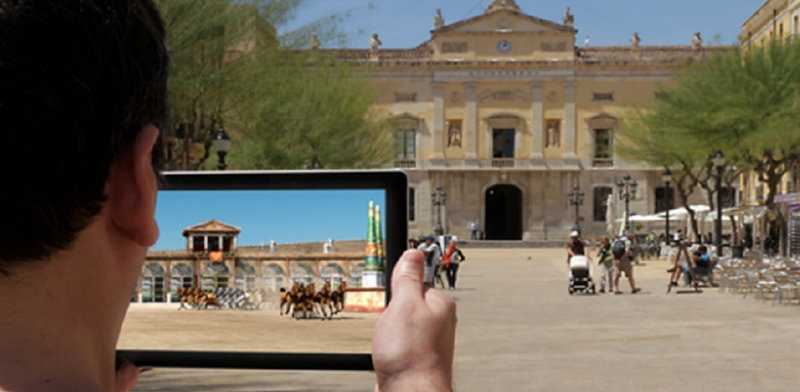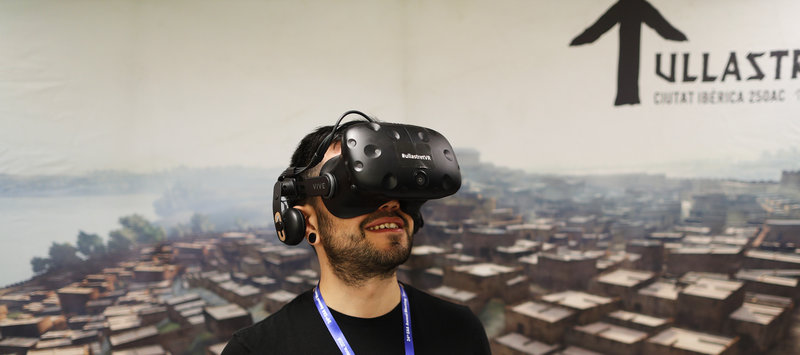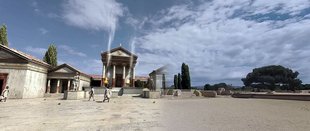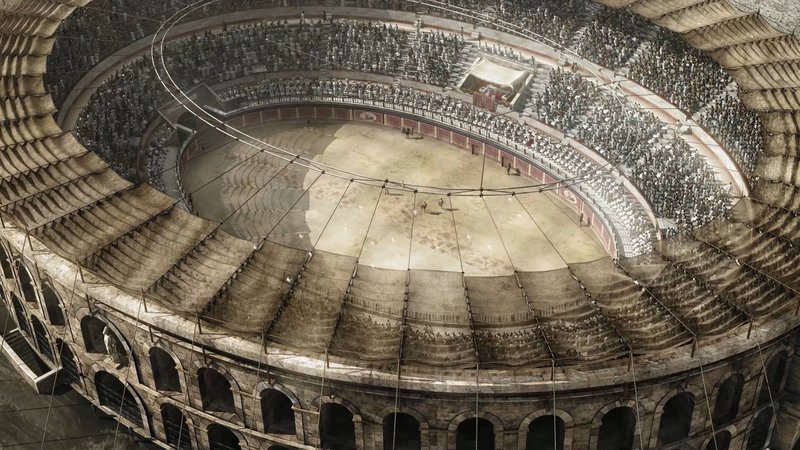Smart Heritage
Advanced technology is being used to virtually recreate heritage sites through the use of applications for 3D goggles, tablets and smartphones to provide an immersive experience for so-called hyperconnected tourists
“We have to adapt to new technology in the heritage sector” “The visitor feels like they are walking through the site”
Heritage is being brought to life thanks to advanced technology. The Imageen Tàrraco app uses augmented reality to show sites as they were
If you were to take a walk through Font square in Tarragona, it would be hard to imagine that some two thousand years ago, in this very same place, the Romans held their popular chariot races. Below your feet would be the site of the Roman circus, of which there are some remains, but its former glory is now long gone. Equally, if you were to go to see the ancient remains in Empúries and Ullastret, perhaps it would be just as hard, looking at the stones sticking a few feet out of the ground, to imagine the splendour of the original structures.
That is why those who manage these heritage sites have found ways to make the remains more accessible and understandable to visitors by offering them pioneering applications that virtually reconstruct the sites using the latest technology. With 3D virtual reality goggles or with a tablet that shows historical recreations with augmented reality, the visitor can now see, or rather take part in, an immersive experience. The archaeological site of Tàrraco, along with those in Empúries and Ullastret, are just three examples of how ancient heritage is now being brought to life, thanks to the application of advanced 21st-century technology. It is a case of using the tools of the future to open a window into the past.
The application of this advanced technology to heritage has much to do with the unstoppable growth of the so-called hyperconnected tourist, travellers who not only use mobile devices to help plan their trips, but who also want to use these tools for new experiences. “We have a permanent need to be connected to the network,” says Laura Romero, member of the technical team at the Ullastret site.
Tarragona
One response to this new demand can be seen with Tarragona’s Roman heritage. Imageen Tàrraco is an app that uses augmented reality to show sites as they once were. Launched in 2015 by Andrés Serrano and the Digivisión company, it was the first app of its kind in the world to fully virtually reconstruct an ancient city: Tarragona. “A few months later IBM did the same with Pompey, but we were the first in the world,” says José Antonio Muñiz, the head of this company based in Reus, in Baix Camp, and the company was also one of the first firms to create computer animations of such a site: “We have always been at the forefront,” boasts Muñiz.
So, what is Imageen Tàrraco? It is an application – which can be downloaded for free– available on smartphones, tablets and 3D glasses – that uses virtual reality techniques to provide an immersive experience of ancient Tàrraco – the Roman name for Tarragona – by virtually recreating the amphitheatre, the Roman circus, the Colony forum, temples and the Diable aqueduct.
In the first 14 months since its launch, Imageen had clocked up more than 150,000 downloads, while visits to the sites have risen by 25%. Digivisión and the city council are now working together to offer other heritage sites using this technology, such as the keep of the Roman circus and the Barà arch, both of which have been declared World Heritage Site by Unesco.
How it works is that the visitor goes to one of these sites and, with a tablet, smartphone or 3D glasses, can see what the place looked like more than two thousand years ago, thanks to computer-generated augmented reality images. “And they cannot only see what it was like from the architectural point of view, but also the experiential part. If they go to the Font square in Tarragona, they will see how the Roman circus fit with the square, but they’ll also be able to see the chariot races and the cheering spectators. And if they go to the amphitheatre, they will be able to see fights between gladiators... We not only show what was on these sites, but also what happened there,” says Muñiz. The remains in Llosa de Cambrils (Baix Camp), the medieval route in Espluga de Francolí (Conca de Barberà) and the remains in Empúries (Alt Empordà) are other examples of heritage sites that are now preparing to use the application.
Empúries
Last summer, the Museu d’Arqueologia de Catalunya (MAC)-Empúries also launched an initiative that allows visitors to immerse themselves in antiquity through virtual reality. The museum has 3D glasses and tablets so that visitors can see what the ancient city’s forum looked like. The museum is now preparing to add 3D views of the agora and the stoa. So far, only certain parts of the site have been virtually reconstructed, which Joaquim Tremoleda, conservator and archaeologist at Empúries, says will be gradually added along with other areas. The new itinerary goes along with the site’s existing audiovisual guide for the cryptoporticus (covered passageway) of the domus of mosaics. Virtus Màgic is the company that developed an application for providing additional information about the site.
Meanwhile, the new visitors’ reception centre offers a general presentation of the ancient Greek and Roman city of Empúries “that combines information and virtual reality, especially about the paleo-landscape.” “This allows the visitor to get a global idea of the whole site, because once you are inside it you only see a part of it, and it also shows them what the ancient landscape was like. This is a great resource because it allows us to show, in a very visual way, things that can often be very difficult to explain. It helps make the visit far more engaging,” says Tremoleda. For next year, the site is looking to remodel its permanent exhibition room, which will also include 3D virtual reality images. “As the public, and in particular young people, are now used to this medium, we have to use resources that speak their language and that at the same time are of high quality,” says Tremodela. “We have to adapt to new technology in the heritage sector,” he adds. Meanwhile, the same company, Virtus Magic, has developed a 3D view of another site in the Girona area: the Roman villa of Vilauba (Camós).
Ullastret
It seems as if the use of technology to virtually recreate heritage sites seems unstoppable. The remains in Ullastret have a 3D virtual recreation of the entire site. Summer of 2016 saw the inauguration of an immersive room in which an audiovisual 3D recreation of the Iber city is screened. “Being immersive, the visitor feels like they are walking through the site,” says Laura Romero, member of the MAC technical team in Ullastret. The multidisciplinary team made up of archaeologists and 3D specialists gathered all of the archaeological information and used it to make a recreation. One peculiarity is that “the process was not carried out with the usual computer tools used in architecture or archaeology, but with an IT tool used to make video games,” says the site’s management. Specifically, the Unreal Engine was used, a video game technology applied to interpreting heritage. Ullastret has HTC Vive virtual reality goggles, which so far have only been demonstrated in congresses: “They are not usually provided to visitors because it would be too difficult for them to move around the site while wearing the goggles,” says Romero. She also says they are currently working on a 3D reconstruction of another part of the site, which will be unveiled later this year.
So, does this mean the end of audio guides? For heritage managers, this tool still has plenty of life in it. “Imageen is a product that will eventually replace audio guides, because it offers so much more, not only audio, but also video and augmented and virtual reality images. Imageen and other similar applications will eventually displace audio guides, but that will be a gradual process,” says Muñiz.
feature technology
feature technology
Doc leads the way in VR tech
The ancient sites of Tàrraco and Empúries appear in the Ingeniería romana documentary series produced by the Digivisión company that has pioneered the use of virtual recreations. The first two episodes, out of a total of eight, aired some time ago on Spanish television, with the next two screened in February. The 55-minute episodes are of the highest technical quality, and were produced at a cost of€2 million, most of which was financed by Digivisión. The production company has also had the support of the Structuralia and Gradhermetic companies, as well as public authorities, such as Tarragona city council. For the heritage managers of the Tàrraco and Empúries sites, appearing in the series is the best promotional tool.“They are products that help a lot with spreading the word and reaching a wider public,” says Joaquim Tremoleda. “When documentaries are made in southern Europe, they are usually low-cost productions that struggle to find an international market. Our goal is to sell the series to lots of foreign television channels, and to do so without being the BBC,” he adds.


